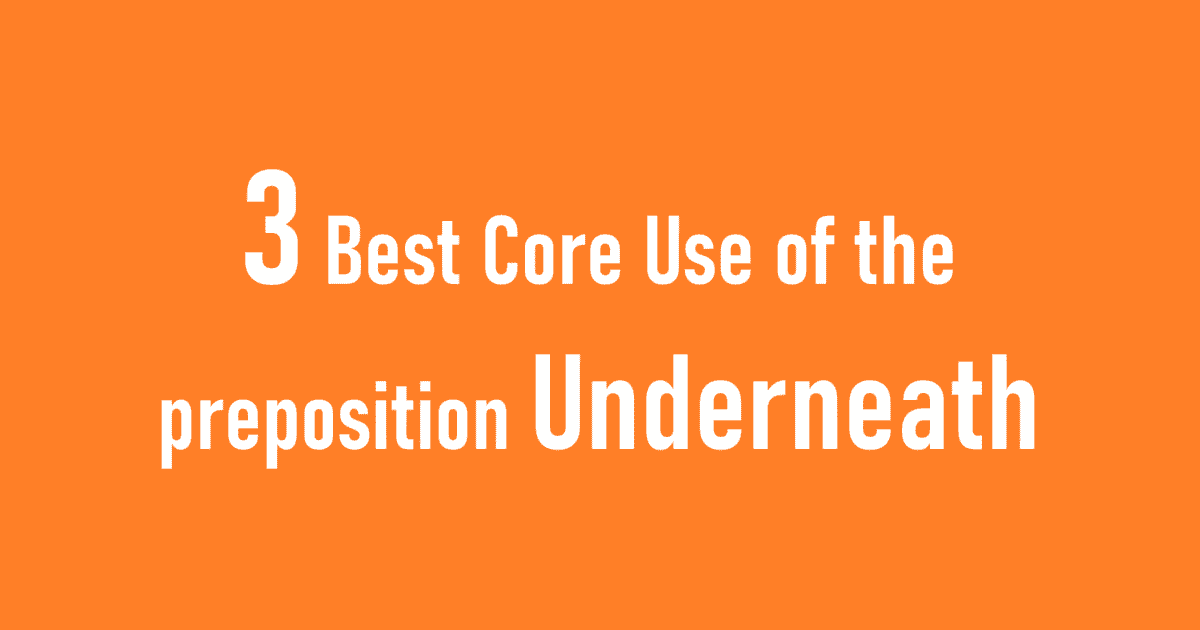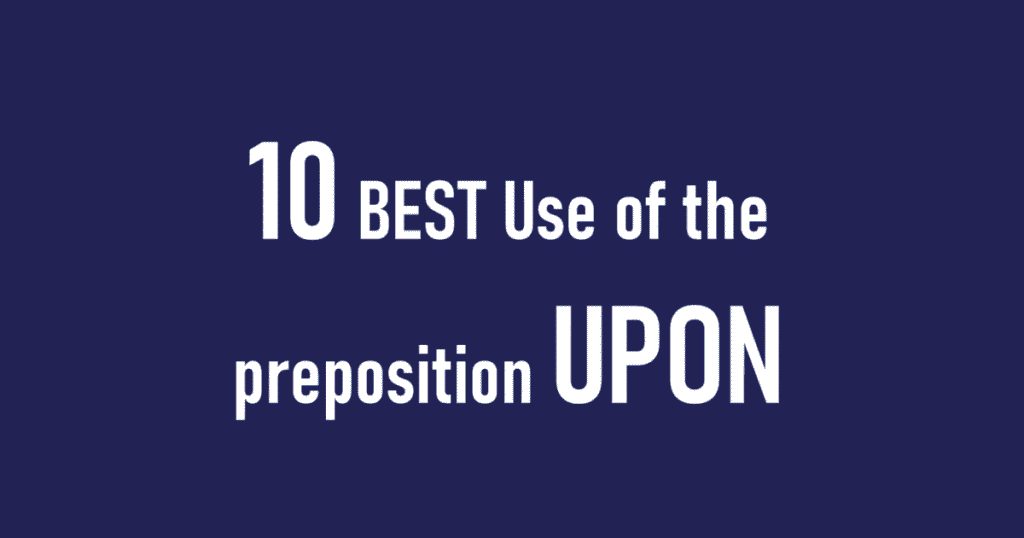Use of the preposition Underneath. The English language is rich with prepositions, those small but mighty words that dictate relationships between nouns and pronouns, adding crucial context and spatial awareness to our sentences. Among these, “underneath” stands out as a more nuanced and often overlooked synonym for “under.” While seemingly interchangeable, understanding the subtle differences in usage and connotation can elevate your writing and speaking, adding depth and precision to your communication. This post will explore the various facets of “underneath,” from its core meaning to its less common applications, offering a comprehensive guide to mastering its use.
Use of the preposition Underneath
The Core Meaning: Spatial Relationships and Physical Position
At its most fundamental level, “underneath” signifies a position directly below something else, often implying contact or a close proximity. It describes a spatial relationship where one object is covered, sheltered, or supported by another. Think of a cat nestled underneath a blanket, or the roots of a tree sprawling underneath the soil.
Here are some examples illustrating this core meaning:
- “The child hid underneath the table during the game of hide-and-seek.” (The table provides cover and is above the child.)
- “The mechanics found a leak underneath the car.” (The leak is located on the underside of the vehicle.)
- “A network of tunnels runs underneath the city.” (The tunnels are located beneath the surface of the city.)
- “She wore a warm thermal shirt underneath her sweater.” (The thermal shirt is worn directly under the sweater, close to the skin.)
In these examples, “underneath” effectively conveys the position of one entity relative to another, emphasizing its lower location. While “under” could be used in these sentences without causing a grammatical error, “underneath” often adds a subtle emphasis on the closeness or directness of the spatial relationship.
Beyond the Literal: Connotations of Concealment and Covering
While “underneath” primarily indicates spatial position, it often carries connotations of concealment, covering, or protection. It can suggest that something is hidden from view or shielded from the elements. This nuance distinguishes it from “under,” which can simply denote a lower position without necessarily implying concealment.
Consider these examples:
- “She kept her secrets buried deep underneath a facade of cheerfulness.” (The secrets are hidden and concealed by the facade.)
- “The treasure was hidden underneath a layer of rocks and dirt.” (The rocks and dirt are deliberately used to cover and conceal the treasure.)
- “He felt a wave of anger simmering underneath his calm exterior.” (The anger is concealed beneath a surface appearance of calmness.)
In these cases, “underneath” goes beyond simply indicating location. It hints at something being deliberately hidden or obscured. The “underneath” layer acts as a shield or cover, preventing the underlying element from being readily visible or accessible. This nuanced understanding allows for richer and more evocative writing.
The Emotional and Psychological Dimensions of “Underneath”
The connotations of concealment and covering associated with “underneath” extend into the realm of emotions and psychology. We often use “underneath” to describe feelings or motives that are suppressed, hidden, or not immediately apparent. It can suggest a hidden layer of complexity or a more profound truth concealed beneath a surface appearance.
Here are some examples:
- “Underneath her confident demeanor, she felt insecure and anxious.” (The insecurity and anxiety are hidden beneath the confident exterior.)
- “There was a simmering resentment underneath their forced politeness.” (The resentment is hidden beneath the surface level of politeness.)
- “Underneath all the bravado, he was terrified of failure.” (The fear of failure is hidden beneath a display of bravery.)
In these instances, “underneath” allows us to explore the inner workings of individuals, revealing hidden emotions, motivations, and vulnerabilities. It suggests a dichotomy between what is shown and what is truly felt, adding depth and complexity to character development and emotional expression.
“Underneath” vs. “Under”: Dissecting the Subtle Differences
While often used interchangeably, understanding the subtle differences between “underneath” and “under” is crucial for precise and effective communication. Here’s a breakdown of key distinctions:
- Emphasis on Contact or Closeness: “Underneath” often emphasizes a closer proximity or direct contact than “under.” Think of a blanket “underneath” you on a cold night versus a tree “under” which you are standing. The blanket is in direct contact, while the tree simply provides shelter from above.
- Connotation of Concealment: “Underneath” frequently carries a stronger connotation of concealment or covering than “under.” A layer of dust “under” the furniture simply indicates a location, while a layer of deception “underneath” their friendship implies a deliberate attempt to hide something.
- Formality and Tone: “Underneath” can sometimes feel slightly more formal or emphatic than “under.” While both are acceptable in most contexts, “underneath” might be preferred in more formal writing or when emphasizing the spatial relationship.
- Usage with Verbs: While both prepositions can be used with verbs (e.g., “to hide under” or “to hide underneath”), certain verbs lend themselves more naturally to one preposition over the other. For example, “to bury underneath” sounds more natural than “to bury under,” due to the emphasis on completely covering and concealing something.
Practical Examples and Usage Tips
To solidify your understanding, let’s look at some practical examples and usage tips:
- Describing Location:
- Instead of saying, “The cat is sleeping under the chair,” consider “The cat is sleeping underneath the chair” if you want to emphasize that the cat is completely shielded from view and potentially touching the underside of the chair.
- Expressing Hidden Emotions:
- Instead of saying, “He felt sad under his smile,” try “He felt sad underneath his smile” to emphasize that the sadness is concealed and contrasts with his outward appearance.
- Illustrating Layers:
- “There were several layers of meaning underneath the surface of the text” conveys a more profound sense of hidden depth than “There were several layers of meaning under the surface of the text.”
- Consider the Connotation: Always consider the intended connotation when choosing between “under” and “underneath.” If you want to emphasize concealment, protection, or a close spatial relationship, “underneath” is often the better choice.
Common Mistakes to Avoid
- Overuse of “Underneath”: While “underneath” can be a valuable addition to your vocabulary, avoid overusing it. Sometimes, “under” is the more appropriate and concise choice.
- Incorrect Preposition Combinations: Be mindful of preposition combinations. For example, “underneath of” is redundant; simply use “underneath.”
- Forgetting Context: Always consider the context of your sentence when choosing between “under” and “underneath.” The best choice will depend on the specific meaning you want to convey.
Conclusion: Embracing the Nuance of “Underneath”
“Underneath” is more than just a synonym for “under.” It’s a preposition with subtle nuances and connotations that can add depth, precision, and emotional resonance to your writing and speaking. By understanding its core meaning, its association with concealment, and its ability to convey hidden emotions, you can effectively leverage “underneath” to enhance your communication and express yourself with greater clarity and sophistication. So, next time you’re tempted to simply use “under,” take a moment to consider whether “underneath” might be the more fitting choice, adding that extra layer of meaning that truly captures the essence of your intended message. Embrace the nuance, and watch your language skills flourish!
Read Also,
- Learn all prepositions
- Use of the preposition above
- Use of the preposition about
- What is Religion
- News in Hindi
- Human vs AI
- Very Important Word Lists
>>> Sir Sahil

